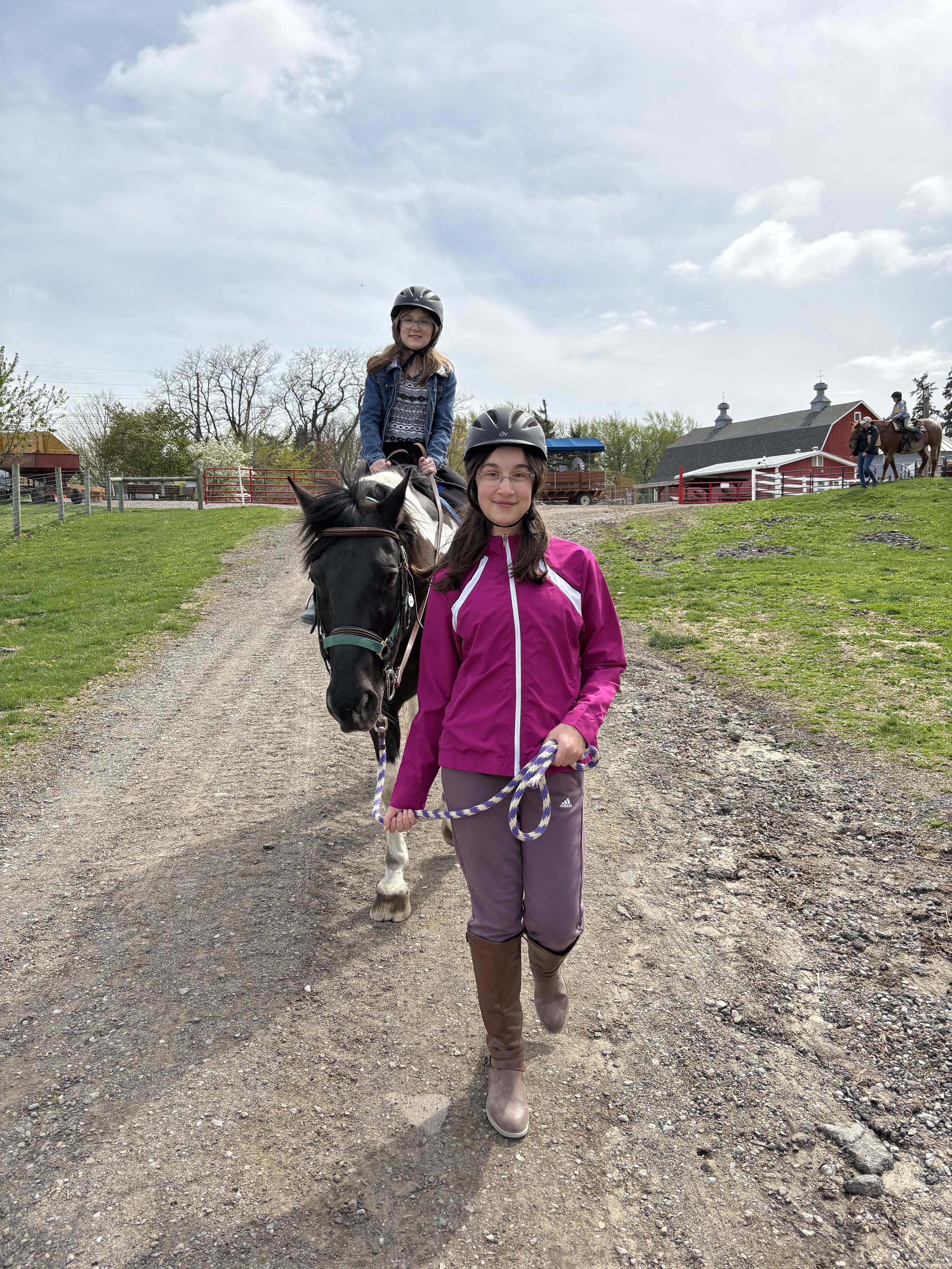Spring Riding Series Update: Trails, Challenges & Guest Ponies!
We’ve officially passed the halfway mark in our Spring Riding Series, and what a fun and busy few weeks it’s been at the barn!
Two weeks ago, we took a well-earned break from the arena and hit the trails for a refreshing ride in the open air. It was the perfect reward for our hardworking riders and a relaxing change of pace for our horses. The fresh scenery, warm sunshine, and happy faces made for a perfect spring outing!
This week, it was back to business—though we kept things fun with a challenge obstacle course set up in the arena. It was amazing to watch everyone shine and rise to the occasion. Riders worked on confidence, control, and quick thinking as they navigated their horses through cones, poles, tight turns , and other tricky surprises. It was rewarding to see skills that we have been working on all season come together in such a dynamic way!
White Badge Riders: First Bareback Ride!
This week was also a big milestone for our white badge riders - they rode bareback for the very first time! Riding without a saddle helps develop balance, coordination, and a closer connection with the horse. It’s no easy feat, but our riders showed courage, determination, and had plenty of laughs along the way (especially during those wobbly first moments!). We’re so proud of them for stepping up to the challenge - you’re on your way to becoming confident, well- rounded riders!
Horse Wellness: Stretching & Cool Downs
It’s not just about riding, with the weather warming up, we also focused on horse care. This week included some gentle horse stretching exercises to keep our equine partners loose and limber. Our students are learning horse to properly stretch and care for their horses’ muscles. Students also spent time, hosing our horses down after a hard days work. These small moments go a long way in building stronger bonds and happier, healthier horses.
Meet Our Guest Ponies: Mellow & Stormy
We had two special visitors in the barn this week—Mellow and Stormy, ponies trained by our family and visiting from our home stables. These two, seasoned show ponies, were a big hit with the riders, offering a fun change of pace and some extra learning opportunities. Our students loved getting to meet them and learn from their experience - and let’s be honest, who doesn’t love a couple of adorable ponies in the mix?
🐴 Rider Tips Corner: How to Cinch a Western Saddle
Cinch too loose and your saddle slips; too tight and your horse is uncomfortable. Here’s how to get it just right:
Place the saddle pad just behind the horse’s withers and slide backward to smooth hair.
Set the saddle gently on top, ensuring it sits level and just behind the shoulder.
From the left side, pull the cinch under the horse's belly and thread the latigo (the strap) through the cinch ring and the saddle d-ring.
Tighten gradually. pull snug, but not too tight - think firm handshake, not a wrestling match.
Always double-check before mounting!
🐎 Know Your Horse Parts:
Here’s a quick anatomy refresher:
Poll – Top of the head between the ears
Withers – The bony ridge at the base of the neck
Barrel – The main body section, where the rider’s legs rest
Croup – The top part of the hindquarters
Hock – The joint on the back legs (like a knee in reverse!)
Forelock – The tuft of mane between the ears
Frog – The V-shaped part on the underside of the hoof
📏 Horse Measuring 101: Height & Weight
Want to know how tall or how heavy your horse really is? Here’s how to do it using a horse height/weight tape - a handy tool in any barn!
Measuring a Horse’s Height:
Horses are measured in hands, a traditional unit of measurement used in the equine world.
1 hand = 4 inches.
Height is measured from the ground up to the top of the withers, which is the ridge between the shoulder blades—NOT the top of the head.
A horse that stands 15.2 hands tall is 15 hands and 2 inches (not 15 and 2/10). The decimal works differently in horse height:
15.0 = 60 inches
15.1 = 61 inches
15.2 = 62 inches
15.3 = 63 inches
16.0 = 64 inches, and so on.
Fun Fact:
A pony is any equine under 14.2 hands. Anything 14.2 hands and taller is considered a horse.
Measuring a Horse’s Weight (Without a Scale):
Most barns don't have a giant livestock scale—but you can still get a pretty accurate weight using a weight tape or weight formula.
🧵 Using a Weight Tape:
Stand your horse square on a level surface.
Wrap the tape around the girth, just behind the front legs and withers.
Read the number where the tape overlaps. This will give you an estimated weight in pounds (or kilograms, depending on the tape).
A healthy adult horse typically weighs between 900–1,200 lbs.
Ponies tend to weigh between 400–900 lbs, depending on breed and build.
Why Does It Matter?
Knowing your horse’s height and weight helps you:
Dose medications correctly
Choose the right tack size (saddles, blankets, etc.)
Monitor health and conditioning over time
Ensure your horse isn't carrying too much weight (including rider and gear)
Horse’s eat 2% of their body weight daily in foreage to maintain weight.
I’m so proud of how far our riders have come this season, and I can’t wait to see what the rest of spring brings. Stay tuned for more trail rides, challenges and pony shenanigans along the way.
Happy Riding
Ms. Lou
Bowers Riding School



































































